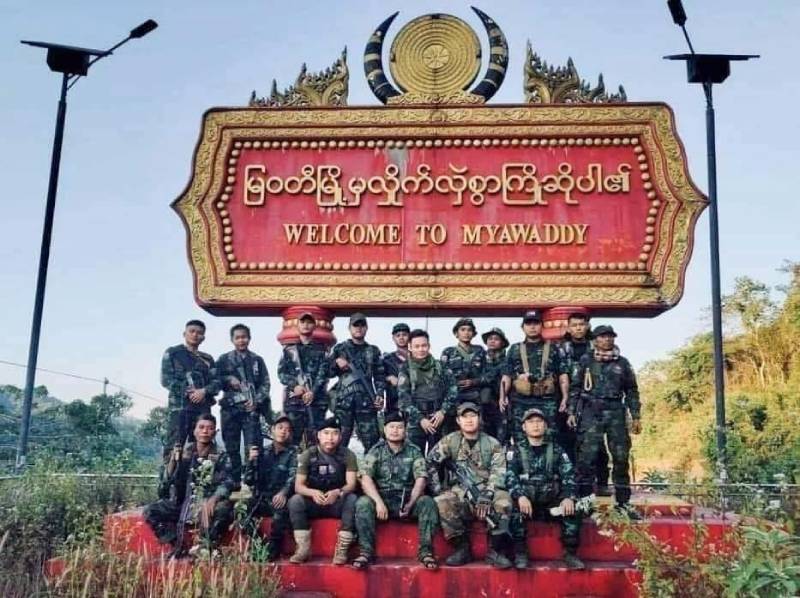Mizzima Commentary
The fall of the important border trade hub of Myawaddy is viewed by many Myanmar watchers as a slap in the face for Senior General Min Aung Hlaing’s military junta.
On the weekend, the Myanmar military was in disarray in and around Myawaddy, with soldiers fleeing either over the border into Thailand, or fighting back from the shade of the Thai-Myanmar Friendship Bridge and then escaping to the river. Columns of junta military reinforcements were reportedly being attacked by opposition forces as they tried to approach the border city in Karen State, apparently intent on retaking military positions. An estimated 1,500 Myanmar nationals fled the city from the latest fighting on the weekend, taking refuge on the Thai side of the border in Mae Sot.
Karen National Union (KNU)-led resistance forces, a loose conglomeration of the Karen National Liberation Army (KNLA), the Karen National Defense Organisation (KNDO) and the People’s Defense Forces (PDFs), launched an assault on Myawaddy town earlier this month, part of a growing push-back against junta positions in Karen State, home to a number of ethnic groups.
Last week, the Myanmar junta confirmed Myanmar troops had withdrawn from their positions in Myawaddy, a clear indication that this loss was impossible to cover up.
It is unclear how serious the junta will be in trying to reestablish control or whether this is effectively a “lost cause” – yet heavy artillery and airstrikes are being used on some resistance positions.
THAI INTERVENTION
On the border near the bustling trading town of Myawaddy, Mizzima and other media personnel in Thailand heard shelling and possibly airstrikes, a reason why thousands of Myanmar people were queuing at the Thai Immigration gate to seek safety in Thailand last week.
Given the importance of the border developments, Thai Foreign Minister Parnpree Bahiddha-Nukara visited Mae Sot on 12 April to observe the situation and to talk to the media, following emergency Thai government meetings held in Bangkok.
Thailand has offered to host up to 100,000 people fleeing from the conflict but is obviously keen to tamp down the conflict and resolve the problem, on both humanitarian and economic grounds. As of going to press, however, the numbers fleeing appeared to be in the low thousands, but not tens of thousands.
Myawaddy is important economically to both Myanmar and Thailand. It matters to the cash-strapped junta, with more than $1.1 billion worth of trade passing through it in the 12 months to April, according to the junta’s commerce ministry. Both countries benefit from the smooth running of the trade hub, the Asia Highway being an important communications lifeline. And there are deeper government ties both in
terms of gas supplies from Myanmar, the recent Thai humanitarian aid delivery to people in need in Myanmar, and an underlying long-standing working relationship between Thai generals and the Myanmar junta hierarchy.
During the Thai foreign minister’s visit to Mae Sot over a week ago, soldiers stood on alert alongside armoured cars at the border in heat of 37 degrees Celsius (99 degrees Fahrenheit), their guns on their APCs pointing towards the Myanmar border. Clearly, the Thai government did not want the chaos to spill over the border to disturb the tranquility on the Thai side – just as Thais were celebrating the Songkran Water Festival (known in Myanmar as Thingyan) on that holiday weekend.
‘HUMILIATING DEFEAT’
What is clear is the complete capture of Myawaddy town is a humiliating defeat for the Myanmar junta, which has suffered a string of battlefield losses in recent months that have even prompted rare criticism of Min Aung Hlaing by his own supporters.
Min Aung Hlaing is reported to be under pressure, particularly after the loss of junta positions as a result of Operation 1027 in northern Shan State that kicked off in October 2023 under the opposition Three Brotherhood Alliance, the loss of positions to the Arakan Army (AA) in Rakhine State, and recent advances by the Kachin Independence Army (KIA) in Kachin State.
The military is spread thin and bunkered down, increasingly relying on air and artillery power to keep the Myanmar resistance at a distance. The junta has been rapped for the thousands of attacks made by air strikes and artillery on civilians over the last three years since the 2021 coup.
Mizzima and AFP reports indicate that the Myanmar junta is sending reinforcements towards Myawaddy, but are facing heavy opposition.
The military is anxious to avoid losing another major town, analysts say, after the humiliating surrender of around 2,000 troops at the town of Laukkai on the northern border with China in January, and the fall of a number of towns and positions in Rakhine State to the forces of the Arakan Army (AA).
But retaking a position is harder than losing a position.
THAI CONCERNS
Thailand’s foreign minister Parnpree warned that his country would not tolerate any violation of its sovereignty, during his visit to Mae Sot.
“Our soldiers are guarding along the border, showing we are ready to protect, and not let anyone violate our sovereignty,” he told reporters. “Thailand has clearly stated that we will not allow anyone to violate Thai soil, we will not accept it.”
The conflict in Myanmar has provoked a Thai response before, with the kingdom scrambling jet fighters in 2022 after junta planes breached the border during operations against anti-coup fighters.
“I have talked to the army chief, we can’t accept if our airspace has been trespassed,” Prime Minister Srettha Thavisin reiterated.
Thai MP Kannavee Suebsang told AFP during a visit to Mae Sot a week ago that the Thai government needs to prepare for a potential influx of people fleeing conflict in Myanmar.
“We need to prepare. We need to plan. We cannot just ignore the situation inside Myanmar,” he said.
There is little doubt that the Thai government is using backdoor channels to liaise with the Myanmar junta over the present crisis and the future of Myawaddy. Analysts indicate it makes little sense for the authorities in both Naypyidaw and Bangkok to see the border town damaged or destroyed. The cold facts for Min Aung Hlaing are that the city has been lost but the junta could still benefit from the city functioning as a trade hub and keeping the Asia Highway open.
The KNU issued a statement saying it was deeply concerned about security for the people of Myawaddy and was seeking peace. The KNU appeared cautious not to rush in to the city.
That has left a vacuum.
Myawaddy is under the control of Maung Chit Thu’s Karen National Army (erstwhile Border Guard Forces), says journalist and author Ashley South. “Having been not much involved in the fighting, the KLA-BGF group snuck in and took the city. Depending on your point of view, this could be rather clever on the part of the KNU – meaning they don’t have to take responsibility for managing the Myawaddy administration (including border relations with Thailand), and also hopefully meaning that the SAC will not directly attack the town, given that the BGF-KNA troops are sort of (or at least were previously) allied with the Myanmar Army. Or – these developments could be seen as pretty sneaky: the KNA-BGF, having avoided the fight, nevertheless get to control the town. As noted, this is still in play.”
Journalist South notes that although downtown Myawaddy might have (so far) been spared, the junta has launched airstrikes on nearby villages and peri-urban areas.
“This has become the normal pattern: after EAOs and PDFs take control of new territory (at least 400 Myanmar Army bases and 50 towns in the past six months), the (junta) retaliates with airstrikes, killing civilians and damaging infrastructure,” South says.
BEGINNING OF THE END?
Does Myawaddy mark the beginning of the end for junta leader Min Aung Hlaing?
As activist Igor Blazevic indicates, the loss of Myawaddy will be a loss of face for the embattled junta leader and he may feel pressured to respond heavily to indicate the junta remains in charge.
But the fall of Myawaddy could go down in future history books as a crucial turning point in the inevitable collapse of the illegal military regime.
Reporting: Mizzima, AFP
Updated version of Inside the fall of Myawaddy published 18 April 2024 in Mizzima Weekly.





